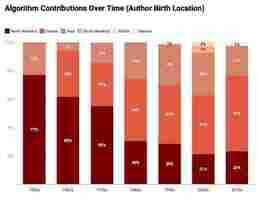How to make AI work for your business
The news about artificial intelligence is mostly dominated by sensational stories such as the ominous threat of deepfakes , deep learning algorithms that create fake blogs , AI bots that create their own language, and generative adversarial networks that create realistic portraits of non-existent people.

But the practical use of AI algorithms is much farther behind than the hype caused by the media. From peer-reviewed breakthrough research presented at mainstream AI conferences to PR-style videos created by large tech companies and well-funded research labs, only a trickle of the innovation we see in the field makes it into real business processes and applications.
And the organizations that are putting AI to good use are those who understand the powers and limits of today’s technology and master the challenges of integrating it into their processes and solutions.
“AI does offer a lot of business value, but much of that value isn’t terribly sexy or visible. Products and processes will be made somewhat better and easier to use. Decisions will be better informed. We’ll continue — and perhaps even accelerate a bit — the amazing progress that we’ve seen over the last couple of decades in data and analytics. But as all of the early adopters have discovered, it’s still difficult to create systems that think and communicate like humans — even in narrow domains,” academic and business author Thomas H. Davenport writes in his book The AI Advantage: How to Put the Artificial Intelligence Revolution to Work .
The book explores the mundane-but-practical side of artificial intelligence that is making a real difference at startups and large organizations. In it, Davenport discusses which organizations and sectors are making the best use of AI, what are the challenges business leaders and decision-makers face in adopting AI technologies, and how to develop a successful AI adoption strategy.
Following are some key insights from The AI Advantage , complemented by some exclusive comments and observations Davenport shared with TechTalks in October.
Hesitation in the adoption of AI technologies
While there’s an impression that AI is seeping into every aspect of life and business (and it eventually will), for the moment, a lot of organizations are on the fence. Albeit interested, many business leaders are loath to invest in a technology that entails a lot of risk.
“Almost every survey suggests that a high degree of enthusiasm about AI exists, but that it’s still early days in terms of broad corporate application,” Davenport writes in The AI Advantage , which is largely based on interviews and examination of AI adoption strategies and outcomes at different firms.
The AI Advantage was written in 2018. Since then and a lot of innovation has happened in the field since then, Davenport stresses that we are still in the early days in terms of production applications.
“A lot of companies did small experiments or pilots, but didn’t fully implement them. I think that companies are realizing that AI will be transformative over the long haul, but only moderately beneficial over the short run,” Davenport said in written comments to TechTalks .
The covid-19 pandemic has also highlighted some of the challenges of AI technologies and has forced companies to reconsider their AI adoption strategies.
“I think the COVID economy has meant that companies are re-prioritizing their applications and emphasizing those that have relatively short payback,” Davenport says, adding that some surveys he has worked on suggest an increased preference in buying AI solutions instead of building them in-house, which may be “a factor of COVID-related conservativism.”
AI adoption limited to tech startups and large companies
Given the barriers and risks involved in the integration of AI technologies, their adoption is currently limited to tech startups and large companies.
“Startups build their businesses around new technologies. Large enterprises are typically next in line; they have the technological sophistication to make informed investments in new technologies, and can hire the people to build and implement new solutions,” Davenport writes in The AI Advantage.
Startups are not bound by established business processes and customers they need to keep satisfied. They don’t have liabilities and commitments that slow them down. They build for the future and raise funding for their ideas and innovations. The founding team already has the required AI talent to build the intended solution. AI is a core component of their business proposition and is integrated into their products from the get-go, therefore they don’t need to worry about making possibly breaking changes to an already working system. Although creating an AI product has many other challenges, startups at least have the fuel and gear to start the journey.
Large tech companies, on the other hand, have the financial resources and the flexibility to launch and manage AI pilot project on the side of their main business. They can create divisions that operate independently and manage their own business models, tailored for the dynamics of new markets created by artificial intelligence innovations. They can hire expensive AI talent and acquire startups that are developing promising technology. And as their proof-of-concept projects meet success, they integrate them into their main products.
More importantly, large companies have a lot customer data, a vital requirement for machine learning algorithms .
Small and medium businesses find themselves in an uncomfortable position. They don’t have the flexibility of startups or the extensive resources of big companies. They are bound to the demands of their current customers and dynamics of the markets they are competing in. They don’t have large data stores and the financial means to acquire AI talent and launch in-house moonshot projects.
And perhaps a key factor that is lacking in small to medium firms from an AI standpoint, Davenport points out in The AI Advantage , is awareness and understanding of what is possible. “Big firms have people whose job it is to look out for promising new technologies and inject them into the organization; small firms usually don’t,” he writes.
“I still see that divide being present. I’m not sure it will change much until traditional software vendors incorporate more AI capabilities into their offerings for SMBs. Then it will be an easy adoption,” Davenport said in his comments to TechTalks . “Before that, I don’t think that most SMBs have the spare time and energy to experiment that large firms do, and they don’t have the pressure to innovate that startups do.”
This does not mean SMBs are entirely deprived of AI innovation. There are established platforms that allow businesses to integrated AI technologies into their processes without much technical effort. One interesting example is natural language processing , which is still one of the most challenging subfields of AI and an active area of research. But while AI researchers continue to advance NLP with new deep learning models , the field has also seen the development of tools such as DialogFlow, which can help you create chatbots for your business and integrate them in your website and social media accounts without in an intuitive way. While DialogFlow is not at the cutting edge of NLP, it is accessible to anyone who can break down interactions with customers into distinct steps.
“Overall, it’s important for anyone implementing cognitive technologies to be aware that they are still somewhat immature. Progress is being made quickly in the current environment, but if your application is on the frontier of that progress you may encounter substantial technical challenges. Before you start with a particular project you may want to assess just how close to the frontier you are likely to come,” Davenport warns in The AI Advantage .
How to integrate AI into your organization’s process
Even when you’re a large company in the right market position, AI adoption is still fraught with perils. “It’s easy to make mistakes if you don’t understand the tradeoffs behind each technology,” Davenport writes. “Understanding these technologies and tradeoffs will inform decisions about which might best address specific needs, which vendors to work with, and how quickly a system of a given type can be implemented.”
The AI Advantage provides some key guidelines that can help companies develop a smooth integration strategy. Here are some of my favorite takeaways:
If your AI integration plan involves machine learning, you’ll need the help of talented data scientists to analytics teams to steer the project in the right direction.
Don’t expect leaps: “In time, cognitive technologies will transform how companies do business. Today, however, it’s wiser to take incremental steps with the currently available technology while planning for transformational change in the not-too-distant future,” Davenport writes.
Plan for redesigning your business processes based on cooperation between AI systems and human operators . “Organizations should think through how work will be done with a given new application, focusing specifically on the division of labor between humans and the AI… Systematic design activity is necessary to determine how humans and machines will augment each other’s strengths and compensate for their weaknesses,” Davenport writes.
No matter how exciting a technology is, if it doesn’t provide business value, avoid it. “Cognitive technology may not result in savings from large layoffs anytime soon, but it does need to provide some business value,” Davenport writes.
The AI Advantage is filled with case studies and examples of successful and failed attempts to integrate artificial intelligence in businesses. The book paints a comprehensive picture of what is working and what isn’t, and how companies can find their way through the treacherous path of achieving AI success.
Per Davenport: “There is no reason virtually every large company shouldn’t be exploring cognitive technologies. Those who explore them earlier and more successfully, those who integrate AI with their business processes, and those who identify and nurture effective collaborations between humans and machines — those companies will dominate the future. They’ll have more appealing products and services, more productive and effective processes, and people who have the time and freedom to be creative and resourceful on behalf of customers.”
This article was originally published by Ben Dickson on TechTalks , a publication that examines trends in technology, how they affect the way we live and do business, and the problems they solve. But we also discuss the evil side of technology, the darker implications of new tech and what we need to look out for. You can read the original article here .
MIT study: The US increasingly has immigrants to thank for its algorithmic dominance
A new MIT CSAIL study has revealed that while the US still leads the world in the development of algorithms, immigrants working at the country’s institutions are increasingly responsible for the innovations.AI

The research team reported the findings after combing through 57 textbooks and more than 1,000 research papers to create a list of 180 algorithms that were either the first to solve particular problems or had improved existing fundamental methods. They call their collection the “Algorithmic Commons.”
The team then extracted information about the institutions and birth countries of the authors of the papers. They found that around two-thirds of the contributions were made at US institutions, but that in the last 30 years more than three-quarters of them have come from foreign-born researchers.


Their analysis suggests a country’s wealth is the key driving force behind its algorithmic output. On average, a $10,000 jump in GDP per capita produced a bigger surge in contributions than a population increase of 100 million people.
“There’s a danger that algorithm development may suffer from the problem of the ‘lost Einsteins,’ where those with natural talent in under-developed countries are unable to reach their full potential because of a lack of opportunity,” said study co-author Neil Thompson, a research scientist at MIT CSAIL.
The research also shows the importance of federal funding for university research. Some 82% of the algorithms came from nonprofits and public institutions, compared to just 18% from private companies.
“It is much more efficient for society to have a university researcher discover a new algorithm and share it with the world than to have each company invent it separately,” said Thompson.
The study comes amid concerns that Donald Trump ‘s anti-immigrant policies are driving global tech talent to other nations — and hopes that his successor will reverse the rules.
“If we want the United States to continue to be ground zero for computer science, we need to make sure that our policies make it easy to continue to bring international researchers to our institutions,” said Thompson.
Satellite data has become a key battleground in the Ukraine war
On March 1, the Vice Prime Minister of Ukraine, Mykhailo Fedorov, made an appeal to eight commercial satellite operators.

“Russia is bombarding our cities every day and night and so many civilians are in danger,” Fedorov wrote in a letter shared on Twitter .
“We badly need the opportunity to watch the movement of Russian troops, especially at night when our technologies are blind in fact!”
Fedorov urged the companies to provide satellite imagery to Ukraine’s armed forces. He asked them to collaborate with EOS Data Analytics ( EOSDA ), a satellite imagery firm that will help process the data .
Fedorov emphasized a need for data from one instrument in particular: synthetic aperture radar (SAR).
Ukraine’s government also wants the birds-eye views provided by optical data, but this imagery has major blindspots.
Optical satellites use visible, near-infrared, and short-wave infrared sensors to produce images, which makes them ineffective when it’s overcast or dark.
SAR overcomes these limitations by bouncing microwave pulses to Earth and back. The sensor then makes an image from the returned echoes.
“Live SAR data delivers critical insights on the enemy troops’ disposition, relocation, and refueling at night, regardless of cloudiness — and this is what optical data can’t provide,” Aleksey Kryvobok, Chief Science Officer at EOSDA , told TNW.
Some companies have already answered the call for SAR data.
They include Canadian firm MDA, which this week announced that it’s received permission from the government of Canada to share the imagery.
“Images captured by MDA’s SAR technology , which is unique for its ability to see through all weather and cloud conditions, will be merged and analyzed with other sources of imagery from commercial Earth observation companies to develop comprehensive near real-time intelligence reports for Ukrainian government officials,” said Mike Greenley, CEO of MDA, in a statement.
However, not every satellite firm has responded to the plea.
Concerns have been raised over regulatory problems , Russia jamming the satellites , and the broader risks of private companies entering an armed conflict .
Nonetheless, EOSDA believes the data can provide crucial assistance in both military and humanitarian efforts.